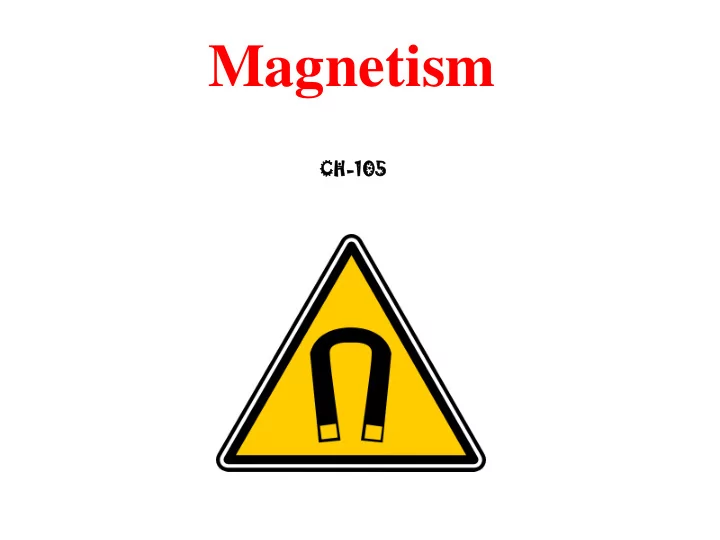

Magnetism CH CH-105
LS-HS transition tuneable with light: Applications Display Device (3) (2) Display Compound in Low spin state (Thin Layer) 2
From Basic Science to Real time applications: Story on HS-LS complexes (Not for exam) A Fe(II) HS-LS compound: Colour change Room Temperature M T / cm 3 mol -1 3 Red T C T C White T / K O. Kahn, C. Jay 0 and ICMC 350 300 250 3 Bordeaux
Magnetochemistry Electron spin: An electron has two intrinsic spin states, which are referred as up and down or alpha and beta. Electron orbital motion: A magnetic field is generated due to the electron moving around the nucleus. Nuclear spin: Some nuclei, such as hydrogen, have a net spin, which generates a magnetic field. Mutual interaction also and with external magnetic field Shows effect strong/weak and negligible.
Magnetism
Magnetism Molar Susceptibility Type: Mass (gram) susceptibility, χ g Volume susceptibility, κ Molar susceptibility, X m Interrelation: Χ g = κ/ρ where ρ is density X m = X g x M.Wt. Where, M. Wt. is molecular weight of the sample Measurable quatity (X m ) - related to atomic properties Summary: Volume mass molar SUSCEPTIBILITY
Magnetism Magnetic moment (µ) from susceptibility ( )
Magnetism
µ total µ orbital µ spin e -
Conditions of orbital angular momentum (µ L ) The orbitals should be degenerate (t 2g or e g ) Similar in shape and size Interconvertible by rotation eg: t 2g orbitals into each other by 90 o rotation. Such transformation is not possible with the orbitals of e g . The orbitals must not contain electrons of identical spin during this transformation and the movement of electron These conditions are fulfilled only when one or two orbitals contain partially filled electrons in t 2g and NOT in e g
Octahedral complexes The degenerate t 2g orbitals (d xy , d xz , d yz ) can be interconverted by 90 ° rotations e.g. the d xz orbital is transformed into the d yz orbital by a rotation of 90 ° about the z -axis – during this rotation the electron is orbiting the nucleus Thus, an electron in a t 2g orbital can contribute to orbital angular momentum x y 12
d yz d xz z z z x x 90 o rot. 90 o rot. x d yz y y y 13
Octahedral complexes However the e g orbitals (d z 2 and d x 2 -y 2 ) cannot be interconverted by rotation as they are different shapes Thus an electron in an e g orbital can not contribute to orbital angular momentum 14
But an e g ------> t 2g transformation is possible dxy / dx 2 -y 2 orbital motion about z axis dxz / dyz orbital motion about z axis dxz / dxy orbital motion about x axis dyz / dxy orbital motion about y axis 15
Orbital contribution to the magnetic moment high spin octahedral d n ions think of possible t 2g electron arrangements d 1 d yz d yz d yz d xz d xy d xz d xy d xz d xy Possible t 2g arrangements = 3 d 1 e.g. Ti(III) Orbital contribution = YES d 2 d yz d yz d yz d xz d xy d xz d xy d xz d xy Possible t 2g arrangements = 3 d 2 e.g. V(III) Orbital contribution = yes 16
Magnetism Orbital Contributions in Octahedral Complexes
Magnetism Orbital Contributions in tetrahedral Complexes
GS = Ground electronic State; ES = Excited electronic State
Orbital contribution to the magnetic moment Contribution due to the excited state(s) think of possible t 2g electron arrangements t 2g not comp. t 2g filled Ni(II) d 8 filled Excited state Possible t 2g arrangements = 1 Orbital contribution = NO d 8 high spin ES Possible t 2g arrangements = 3 Orbital contribution = YES μ exp > μ s for Oct. Ni 2+ 20
Therefore for O h Ni(II) the magnetic moments are larger if the GS-ES gap is small. BUT FOR Tetrahedral Ni(II) situation is entirely different …. d 8 HS Tetrahedral Possible t 2 arrangements = 3 Orbital contribution = YES Μ exp O h Ni(II) is smaller than Μ exp T d Ni(II) 2- , Ni(HMPA) 4 2+ (HMPA=hexamethyl phosphoramide) Exp. NiCl 4 have mag. moment larger than 4 BM. (Larger the distortion smaller the mag.moment ) USEFUL IN DISCRIMINATING O h vs T d structures. 21
Magnetism Lanthanides and their complexes
Magnetism Magnetic properties of lanthanides FACT: The f electrons in lanthanides are buried in the (n-2) shell
Magnetism Spectroscopic Terms (Term Symbols) Different microstates exists for the same electronic configuration. Russel-Saunders coupling is used to describe the terms. The symbol will represent the total value of azimuthal quantum numbers (L = l i ) and it takes the letters, ‘ S, P, D, F, G ’ respectively for L values of 0, 1, 2, 3 and 4. The degeneracy (2S+1) {S = sum of all the spins} is shown on the left superscript. The term symbol is shown as (2S+1) L {for eg., 3 F corresponds to S = 1 and L = 3} Number of microstates for 3 F is, (2S+1) x (2L+1) = 3 x 7 = 21
Magnetism
Magnetism
Magnetism
Magnetism
Magnetism Magnetic States of Matter
30
Magnetism Magnetic States of Matter
Magnetism Magnetic States of Matter
Magnetism Magnetization
Magnetism Neutralization
Magnetism Magnetic States of Matter
Magnetism Hard Ferromagnet As permanent magnet Soft Ferromagnet Used in transformers
Magnetism
Magnetism
Magnetism Problem
Magnetism Problem This is understood from Spectroscopy. Without going into the spectroscopy related parameters, it can be said that the d 8 will be diamagnetic if it were square planar.
Magnetism Problem
Recommend
More recommend